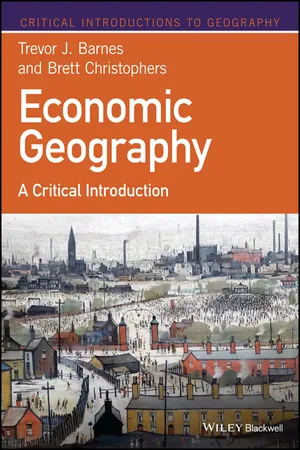
Economic Geography
A Critical Introduction
- English
- ePUB (mobile friendly)
- Available on iOS & Android
About this book
This volume in the celebrated Critical Introductions to Geography series introduces readers to the vibrant discipline of economic geography. The authors provide an original definition of the discipline, and they make a strong case for its vital importance in understanding the dynamic interconnections, movements, and emerging trends shaping our globalized world.
Economic Geography addresses the key theories and methods that form the basis of the discipline, and describes its "communities of practice" and relations to related fields including economics and sociology. Numerous illustrative examples explore how economic geographers examine the world and how and why the discipline takes the forms it does, demonstrating the critical value of economic geography to making sense of globalization, uneven development, money and finance, urbanization, environmental change, and industrial and technological transformation.
Engaging and thought-provoking, Economic Geography: A Critical Introduction is the ideal resource for students studying across a range of subject areas, as well as the general reader with an interest in world affairs and economics.
Frequently asked questions
- Essential is ideal for learners and professionals who enjoy exploring a wide range of subjects. Access the Essential Library with 800,000+ trusted titles and best-sellers across business, personal growth, and the humanities. Includes unlimited reading time and Standard Read Aloud voice.
- Complete: Perfect for advanced learners and researchers needing full, unrestricted access. Unlock 1.4M+ books across hundreds of subjects, including academic and specialized titles. The Complete Plan also includes advanced features like Premium Read Aloud and Research Assistant.
Please note we cannot support devices running on iOS 13 and Android 7 or earlier. Learn more about using the app.
Information
Chapter 1
Why Economic Geography Is Good For You
- 1.1 Introduction
- 1.2 “May You Live in Interesting Times”: Economic Geography’s World
- 1.3 Being Critical: In What Sense a “Critical” Introduction to Economic Geography?
- 1.4 Outline of the Book
- 1.5 Conclusion
1.1 Introduction
the most amazing thing is, almost no one in America knows its name. Isn’t that remarkable? That there’s a city where almost all of our crap comes from, and no one knows its name? I mean, we think we do know where our crap comes from. We’re not ignorant. We think our crap comes from China. Right? Kind of a generalized way. China.But it doesn’t come from China. It comes from Shenzhen. It’s a city. It’s a place.(This American Life 2012)
1.2 “May You Live in Interesting Times”: Economic Geography’s World
1.2.1 Interesting times
- First, and going directly to Mr Daisey and the Apple factory, is pervasive globalization, a fundamentally economically geographic phenomenon. Economic geography inheres in globalization’s very definition; it is part of the term’s conceptual furniture. By globalization we mean the ever‐increasing economic geographic integration of the world as measured by the movements across national borders of: (i) goods, services, and capital; (ii) labor (people); (iii) knowledge and information (communication); and (iv) cultural goods and activities – sports, cuisines, electronic games, films, music, TV shows, and so on. Globalization goes back a long way, of course. The Ancient Greek poet Homer (that is, if he ever existed!) was writing about globalization as early as around 800 BCE in his epic poem The Odyssey. It featured the soldier and sailor Odysseus and his spectacular global travels (at least global for 800 BCE), involving murderous Cyclops, enchanting and beautiful but deadly temptress Sirens, and evil sea monsters Scylla and Charybdis (Figure 1.1). Globalization is enormously long‐standing, but over the last 30 years or so there has been a quantitative shift in its pace and range, and a qualitative shift in its form. Since 1980 there has been a tenfold growth in the value of world trade in goods and services (US$2.4 trillion in 1980 versus US$23.3 trillion in 2013 in constant dollars); a more than twenty fold increase in the value of the stock of global foreign direct investment (a little over US$1 trillion in 1980 and more than US$22 trillion in 2013); a more than doubling in the number of foreign workers now employed across the world (currently about 3% of the entire world’s population); a fiftyfold increase between 1980 and 2008 in the number of minutes that US telephone subscribers spend annually making international calls; and a substantial increase i...
Table of contents
- Cover
- Title Page
- Table of Contents
- Acknowledgments
- List of Figures
- Chapter 1: Why Economic Geography Is Good For You
- Part I: Thinking Critically about Economic Geography
- Part II: Doing Critical Economic Geography
- Chapter 13: Conclusion
- Index
- End User License Agreement